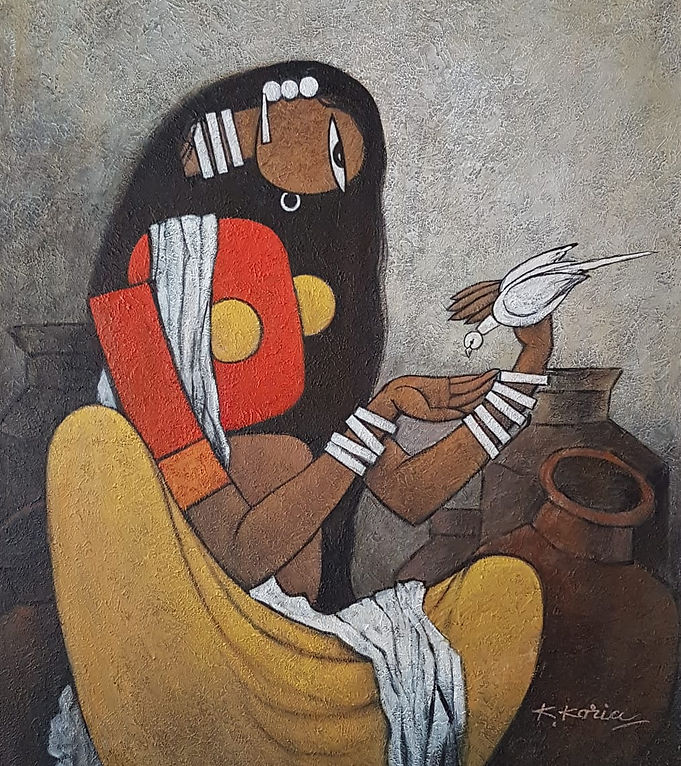WORK by KAMAL KORIA
Kamal is a UK-based artist with a career that spans over 40 years. His practice has made a significant difference to the South Asian art market in the UK and across the continents.
Working as a commercial graphic artist in the UK, he readily responded to orders and commissions and was later deemed as a ‘Fine Artist’. He could then focus on creating his sketchbooks and derived paintings from these, though sometimes the sketches would remain untouched in his cupboard for years.
Join Khyati Koria-Green, his daughter and curator, to hear about Kamal’s journey as an artist.

Gaughan
Kamal poetically captures a glimpse of human nature and a nostalgic sense of his childhood memory. ‘Gaughan’ shows a couple working together in their daily duty within village farming life. It takes us on a journey on winding dusty roads framing people’s everyday lives, gendered expressions, and evocative moments. He provided a sketch of rural India from his collection of unpublished material for the GRID Heritage project.

Rural India in sketch
As Kamal says:
‘My work is inspired by my childhood memories. I often visit India, where I am now considered an outsider. I try to capture that childhood memory, that feeling and atmosphere. During my visits, I take a lot of photographs, which inform my sketches and paintings. This reflective notion has only been achieved with time. I guess others are also looking for that connection of life before we became so busy and distracted by technology, which is why the subject of my work resonates with many. Time has been a key ingredient.’

Taara
Kamal often depicts women in his paintings in small groups, in a family setting, with a child, or alone in private moments of contemplation. His intention is to show women as they are in their domestic setting but allow them to take up the space as in ‘Taara’, focusing on their presence away from the male gaze and patriarchal society.

Whisper
‘Whisper’ shows stylised figures of women. Colours and textures are used to throw light on the recuperative power of art. Kamal says:
‘I believe it is necessary to capture and document personal accounts and experiences. Through specific questions to guide the narrative but to also allow stories flow and unfold, offering new undetermined narratives.’

Parakeet
His paintings carry minimal facial expressions captured by the slight tilt of a head, a shadow or that single eye often looking back at the viewer in a defiant gesture. In ‘Parakeet’, the bodily gestures are often fluid and connect to hidden objects requiring further reflection.
Various questions arise from his paintings: when the woman looks in the mirror does she see herself, does she see a reflection of the person she will be to the outside world, or is she returning the gaze back to the viewer? The bindi - otherwise known as ajna chakra - is often positioned between the eyebrows in his works. It is considered to be the seat of wisdom, latent knowledge, and a point of concentration achieved through meditation.

Love Bird
‘Love Bird’ portrays a lady feeding a white bird in a domestic setting. Only her clothes express colour, the atmosphere remains muted. Her loving expression as she gazes upon this bird is captured in a single eye. Kamal says:
‘Women are often shown with birds in my work. The birds signify freedom, the female looking longingly at the bird suggests a longing for her own freedom.’

Village Queen
‘Village Queen’ portrays a woman proudly sitting. Poised confidently, she looks to the viewer with her powerful, commanding and somewhat defiant expression. Her confidence is echoed in the space that she fills on the canvas. This unapologetic expression defines the role of many strong women whose stories remain untold.

A glimpse of women’s faces sketched in his bold style suggests a depth of meaningful traditions for women in the household while pointing to gradual changes in the lived experience of the diaspora.
Kamal says:
‘We played an important part in the recent social and industrial history of this country. Contemporary collecting should focus on capturing, documenting and archiving his/her stories for future generations. Maybe this will begin to help place the future displaced generations.’
As an artist, he feels he has been far less ‘public-facing’, though his passion for creating art remained undeterred. Recalling an instance of initial barriers, he mentioned a manager who liked his work but wanted to acquire these through a colleague as he did not want to ‘deal with Indians’.
Despite wider prejudice, Kamal says, ‘I believe, I received more discrimination from my own community who were quite judgemental and never took me seriously, I was frequently criticised for my career choice and was often advised to steer me into a 9-5 job.’
Over the decades, Kamal has now become the lead designer in the market for Diwali cards, wedding invitations and bhangra record cover designs. His iconic image for Jalpur Mill food packaging can be seen in all major supermarkets and his portrait of the late Princess of Wales, Diana, is now part of the royal collection.



